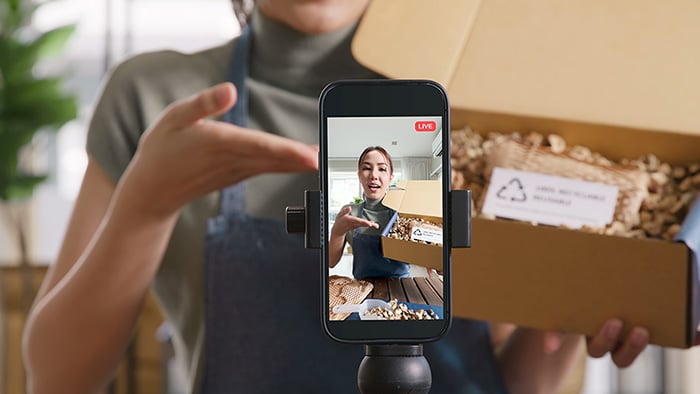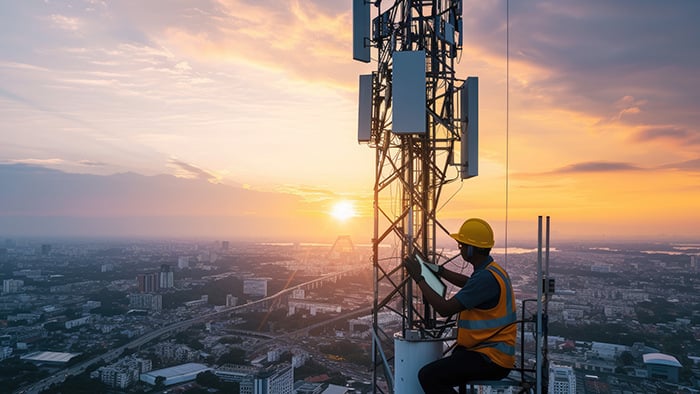How much screen time should children have by age?
The right amount of screen time for kids is a topic largely related to brain development. That’s why screen time by age is an important factor when determining whether and how you should block access, install screen time settings, or manage and limit access to a child’s device and applications.
The brain undergoes most of its development in the first few years of a child’s life. In fact, the average child’s brain doubles in size in the first year alone, and will already grow to about 80% of an adult-size brain by the age of three. As humans, we’re born with all our brain cells, but it’s the neural networks between brain cells that really make the brain work.
Too much screen time for kids — and less discovery through unstructured play and human interactions — means fewer opportunities to build these vital neural networks in our brain. That’s why following screen time recommendations is an important part of developing a happy, healthy child who can realize their full potential.
It’s also the reason why age matters so much when it comes to recommended screen time. A newborn’s brain is a world apart from a five-year-old’s, and a five-year-old’s brain is very different from a teenager’s. So how many hours a week does the average child spend in front of a screen? Probably more than what’s recommended.
 Screen time recommendations by age — toddlers should limit their screen time to no more than an hour a day.
Screen time recommendations by age — toddlers should limit their screen time to no more than an hour a day.
Children under two years
The effects of screen time on babies is controversial and scientifically undetermined. In April 2019, the World Health Organization published screen time guidelines for the first time, with the caveat that they were based on “available evidence,” not “definitive research.”
Too much screen time for kids — and less discovery through unstructured play and human interactions — means fewer opportunities to build the vital neural networks in our brain.
From birth to two years old, the WHO recommends absolutely zero sedentary screen time. So if you’re wondering how much screen time for a two-year-old is the right amount, the simple answer is none.
Other sources like the American Academy of Pediatrics (AAP) discourage screen time for babies under 18 months old, with the exception of video-chatting. They recommend introducing high-quality programming for children only once they’ve reached 18 to 24 months.
There’s a key distinction between sedentary screen time and active screen time. Plopping a baby in front of a screen and letting them watch a random show is different than an engaging video call with a parent who’s away or an educationally focused program made expressly for that particular age group.
A zero tolerance approach may stress out parentswho use cartoons as an easy babysitter while working, cooking, or doing anything else that requires two hands and a bit of distance from a (screaming) child. So these guidelines are meant to serve as a benchmark for healthy family living, not rules etched in stone.
The most important takeaway is that unstructured playtime is more beneficial for a child’s brain development than digital media consumption. Keep this in mind, but don’t let the perfect be the enemy of the good.
Toddlers and children up to five years
Screen time for toddlers gets a bit of a pass, if not a full-on green light. By the age of two, most kids are exploring words, imitating animals, and even cracking jokes. Introducing age-appropriate screen time can actually benefit a child in some ways.
Generally, for children between the ages of two and five, it’s recommended to keep screen time within an hour per day. But, according to pediatrician Dimitri Christakis, “a typical preschool child [in the US] spends about four and a half hours a day in front of the screen.” The key for establishing screen time limits for toddlers is more about content and quality than keeping a close eye on the clock.
Rapid sequencing — nonstop, frenetic, animated action — is vastly different than real-time, slow and meaningful human conversation.
So if you can’t keep your toddler away from the screen, consider the type of stimuli instead. The pace of a TV program has a significant impact on how kids process information. Rapid sequencing — nonstop, frenetic, animated action — is vastly different than real-time, slow and meaningful human conversation.
Compare The Powerpuff Girls Movie (the first movie ever rated PG, instead of G, because of its rapid sequencing) with Mister Rogers’ Neighborhood.
Mister Rogers’ Neighborhood is slow, perhaps even slower than most real-life experiences, and it features actual human conversations. The content is specifically meant to be educational first, and entertaining second. It focuses on sharing, caring, counting, and learning to be a decent member of society. In contrast, The Powerpuff Girls Movie was made purely to entertain. It’s fast-paced, flashy, and jammed with back-to-back action scenes.
Know how a scary movie sticks with you long after it’s over? This is the same for kids. The fast-paced, frenetic pacing of a TV show or app can stick with them (in a detrimental way) even after the screen is off.
Children between six and 12 years
Determining how much screen time a six to 12-year-old should have can get a bit complicated, especially because you might be considering buying your kid their first phone. So, how much screen time is healthy for a teenager, a preteen, or a child still learning to tie their shoes? Broadly speaking, for ages 6 and up, screen time should not interfere with sleep or physical activity.
Consider a child’s non-screen time first, and then set a consistent, rules-based approach to screen time that the whole family can follow.
A good rule of thumb is to focus on non-screen time hours, rather than focusing on screen time hours. Does your child get enough sleep (10 to 14 hours of sleep a night, depending on age), and does your child get at least an hour a day of physical activity?
Consider a child’s non-screen time first, and then set a consistent, rules-based approach to screen time that the whole family can follow.
Children between 13 and 18 years
With teenagers, we begin dealing with the world of social media. Limiting screen time for teenagers becomes a whole new beast once TikTok, Instagram, and YouTube are in play.
The recommended screen time for a 13-year-old is the same as recommended screen time for an 18-year-old — two hours of recreational screen time a day. The distinction between recreational and educational screen time must be accounted for when striking the right balance for a teenager. This is particularly important when online schooling demands so much screen time and as the risks of online threats like cyberbullying become more apparent.
The habits around screen time formed early in life can have lasting effects — both good and bad — on a child’s mental and physical health as they get older.
Understand how often and how long your child needs to look at a screen to complete their school work, attend online classes, and face the realities of student life (especially in the age of COVID-19). Balance these factors with recreational screen time, which might mean reducing recreational screen time considerably while reminding them that there’s a great big physical world out there.
The most important thing is to create good habits. The habits around screen time formed early in life can have lasting effects — both good and bad — on a child’s mental and physical health as they get older, as well as their relationship to digital media in adulthood.
Set up screen time rules with a parental control app
Whether you have a two-year-old going on 20 or a feisty teenager determined to set their own screen time rules, a parental control app makes monitoring and managing family screen time much easier. It used to take a village — now it takes a smart app and a few simple taps.
Parental control apps, like Microsoft Family Safety and similar apps, help parents make the right choices around setting healthy screen time limits. They let parents set up access boundaries around their child's device habits, allowing them to completely shut off internet access when needed. This internet kill switch can be on-demand, or pre-set around school or sleeping hours so that your child can’t go online during school or while in bed.
The risks of too much screen time
The effects of too much screen time on children — like defining the right amount of screen time for children — is debatable. Undoubtedly, too much screen time is bad. Have you ever binged on Netflix, rolling from episode to episode until you were braindead? Well, that can happen to kids, too. Parents of the smartphone generation have some unique challenges.
While research has demonstrated that babies exposed to stimulation get a brain boost, it’s unclear where the limit is — when to turn off the stimulus and how to account for overstimulation caused by our digital lifestyles. But there is consensus that the negative effects of screen time are real and observable, particularly in babies and young people.
Risks can be further categorized into short-term and long-term risks, keeping in mind that short-term risks can develop into permanent obstacles if left unattended. Keeping your family safe online includes monitoring screen time to reduce both types of risks.
Short-term risks
The short-term effects of too much screen time can manifest immediately. These mostly include physical ailments related to poor posture and blue-light exposure. If you stare too long at a screen, you might experience:
-
Headaches or neck and shoulder pain.
-
Irritability and poor behavior.
-
Eye strain or dry and irritated eyes.
-
Poor sleep or restlessness.
A recent Harvard study examined the negative impact of blue light on sleep patterns. Not all light is absorbed by the body, specifically our eyes, in the same manner. Green light, for example, has longer wavelengths and contains less energy than blue light.
Researchers compared the effects of six and a half hours of exposure to blue light and green light and found that blue light suppresses melatonin (an important naturally occurring hormone that regulates our sleep-wake cycles) for twice as long as green light. This means that too much screen time before bedtime has a direct, scientifically observed impact on the body’s ability to fall asleep and stay asleep.
Long-term risks
The long-term effects of screen time on child development and adulthood are especially concerning. Studies of preschool-age children have shown that too much screen time actually alters the structure of the brain, specifically the area responsible for language and literacy development. The long-term risks of too much screen time include:
-
Obesity from lack of physical activity and too much sedentary time.
-
Myopia (shortsighted vision) resulting from too much blue-light exposure.
-
Long-term sleep deficiency stemming from poor screen time habits.
-
Loss of social skills from reduced human interaction.
-
Addiction to the screen-time experience due to overexposure to gamification tactics.
-
Behavioral problems and depression.
-
Mental health issues, such as a much higher risk of ADHD in children under five.
-
Altered brain structure caused by the myelination of the brain’s white matter, which isn’t fully formed until the age of two.
If brain damage and chronic health problems aren’t enough to scare you off the screen, there are also studies that associate too much social media screen time with depression and others that show that test scores improve when mobile phones are banned in the classroom. These long-term problems may start in childhood or adolescence and follow you into adulthood, particularly if unhealthy screen time activities become an integral part of your life.
What about COVID-19 and screen time?
While the message here is evergreen — too much screen time is not good for your children's well-being — the giant elephant in today’s living room happens to be a microscopic pathogen. How can we worry about too much screen time during a global pandemic when kids have to attend remote classes online?
Balance, knowledge, and a bit of acceptance go a long way in establishing healthy screen time habits at all times, but especially during COVID-19. Knowing what your children are doing online (school work, gaming, YouTubing) can help you create an effective plan for finding a balance. Focus on quality over quantity (school interactions are quality), age-appropriate content, and encouraging non-screen time activities like unstructured play, physical activities, and adequate sleep.
What apps should my kids be using?
Navigating the viscous digital waters of childhood is tricky, but as a parent, you must be the captain of the ship. Not all applications are bad, but there are someapps that are very dangerous for kids and should be avoided.
The younger the child, the more important the distinction between passive and active media. Children love to see their impact on the real world. Take, for example, buttons. Have you ever seen a kid go wild over pushing a button? The association between action and result (or input and output) is fascinating and should be a factor in deciding which apps to let your kids use. High-quality, age-appropriate apps that let children interact with the content should be prioritized over passive screen time apps like social media or video streaming.
Keeping your children safe on Facebook, shielding them from the problematic features of Instagram, and determining when Twitter is a safe for your kids are important parts of raising the social media generation. A child’s device or mobile phone should contain only age-appropriate applications. Review them together and help explain the reasons behind this practice. It’s never too early (or too late) to teach healthy screen time habits.
You can find support for screen time monitoring and learn how to make the internet age-appropriate with a parental control app. These apps let you easily block potentially harmful content like social media apps, create customized content filters, and set up automatic alerts to let you know when your child has arrived or left a certain location.
After downloading and setting up your preferred parental control app, make sure to refresh yourself and your children on the basics of internet privacy.
Talk to your kids about not exposing too much personal info on social media or other sites. And make sure your kids (and you!) are using secure settings on Facebook and tight privacy controls on Instagram. There are also built-in parental control settings on Android and built-in parental controls on iPhone, so there are lots of options to make sure your kids stay safe online.
How to limit screen time
Too much screen time means not enough playtime. The key here is how to limit, not eliminate, screen time, while establishing parental controls that act as your partner in internet safety. Here are a few tips to help keep your kids safe online and help them get offline when needed.
-
Set a good example. “Do as I say, not as I do” only works sometimes. Help your kids out by being a good leader. So come on, captain, put your phone down.
-
Create space for screen-free time. Even passive screen time, like having the TV run in the background, counts. Put devices out of sight, so they can be out of mind — and be sure to buy your child a phone only when the time is right.
-
Monitor screen time activity. Sometimes the honor system works, sometimes it doesn’t. By monitoring your kids online and setting limits with a parental app, you’ll know exactly when to call it quits for the day.
-
No screens 90 minutes before bedtime. This holds true even for adults. Pre-sleep screen time directly impacts a child’s ability to sleep well. Create a few scenarios where screen time is simply not an option, such as during school, at night, or during meals.
-
Develop a rewards-based system. A screen time trends chart that tracks good behavior can help determine if screen time has been earned through healthy behavior, or if more chores, homework, or time outside is needed.
-
Focus on active, not passive, media. Seek out interactive screen time situations that let your child interact with the screen (touch screen, age-appropriate learning games or video calls). Sedentary screen time tends to last longer, so avoid this type as often as possible.
- Stick with it. Create habits that are easy to remember, sustainable, and that the whole family can live by. Keeping your family safe online is a team effort, after all.
Keep your whole family safe online with Avast
The internet offers an unlimited range of online experiences. And while much of the online world is safe, not all the content out there is appropriate for everyone in your family. When your kids are online, it can take only one or two inadvertent clicks for them to end up on inappropriate or unsafe content.
That’s just one of the reasons we built Avast One. One of the most comprehensive cybersecurity apps available, Avast One is packed with a suite of security and privacy features to keep your entire family safe online. Stay protected from malicious activity and safeguard your personal information with Avast.














